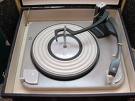 On June 21, 1948. Columbia Records revolutionized recorded music with the introduction of Long Play record albums. The LP was the brain child of a group of engineers, lead by Hungarian born inventor Peter Goldmark, who became obsessed with finding a way to cram more content onto the circular disks that were the current state of the art in analog sound reproduction.
On June 21, 1948. Columbia Records revolutionized recorded music with the introduction of Long Play record albums. The LP was the brain child of a group of engineers, lead by Hungarian born inventor Peter Goldmark, who became obsessed with finding a way to cram more content onto the circular disks that were the current state of the art in analog sound reproduction.
Before 1948, records spun at 78 revolutions per minute and could hold only about 4 minutes per side. The LP changed all that. Initially a disk could hold a total of 45 minutes (about 22 minutes per side) of monaural content. Over the next 40 years, improvements in quality and capacity lead to Extended Play disks that contained 52 minutes, and the audio output grew from one track to two-track stereo and ultimately four-track quadraphonic. LPs were at first available in both 10 and 12 inch varieties, with Frank Sinatra and the New York Philharmonic listed as catalog numbers one and two. The 10 inch disk soon lost out to the higher capacity 12 inch version, which became the standard for a generation of audiophiles until the advent of the Compact Disk.
Each side of an LP contains nearly sixteen hundred feet of groove. At 33 1/3 revolutions per minute, the playback needle travels along the grooves at about one mile per hour. Unlike CDs which change the speed of rotation to deliver a constant data stream, a record player needle travels fastest at the outside edge of the LP.
 Many of us owned players with four speed settings: 16, 33 1/3, 45 and 78 RPM, with thirty-threes and forty-fives being the most popular denominations. Often, we would test the waters of a new act by buying a 45 “single”. If we liked it, we might pop for the LP.
Many of us owned players with four speed settings: 16, 33 1/3, 45 and 78 RPM, with thirty-threes and forty-fives being the most popular denominations. Often, we would test the waters of a new act by buying a 45 “single”. If we liked it, we might pop for the LP.
The longer playing format lead artists to consider how tracks flowed on a side. The Beatles, Stevie Wonder and Pink Floyd made the most of the Symphonic approach to album creation. Unless we were watching the visual separation of each album band, it was sometimes hard for us to figure out where one song ended and the next began.
The 12 x 12 inch size opened up a whole new world to record company marketing departments, who used LP cover art as a way to define an artist’s brand and set a disk apart from the rest on record store shelves.
Some still believe that LPs are superior in audio quality to digital CDs. Club DJs often prefer vinyl to digital as they ply their trade scratching and cross fading tracks to influence the intensity on the dance floor.
 As for Peter Goldmark, he went on to champion the CBS system for color television broadcasting. It was far superior to the RCA NTSC color system, but wasn’t compatible with the millions of black and white TV sets already in use and RCA’s iteration became ubiquitous.
As for Peter Goldmark, he went on to champion the CBS system for color television broadcasting. It was far superior to the RCA NTSC color system, but wasn’t compatible with the millions of black and white TV sets already in use and RCA’s iteration became ubiquitous.

